-
Viewpoint on 'IONS'
Viewpoint on 'Scientific Literacy'
- Proudly sponsored by
-


-
The Smallest Laser Ever
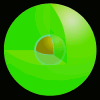
A year before the 50th anniversary of the invention of the laser, laser physicists present a new breakthrough: the nanolaser. It is the smallest laser ever, which makes a whole new range of applications in nanophotonics possible.
-
A Seriously Defocused Spider

A jumping spider about to pounce on its prey needs to be able to accurately measure its distance from its target in order to be able to hit it with precision. This is possible thanks to a visual approach previously unknown to exist in nature.
-
Make Two, Keep One
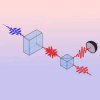
To generate single photons remains a challenge, to have them in a pure, well-defined quantum state even more so. Now this is possible, thus paving the way for future quantum technologies and applications.
Twisted Electrons
Recent experiments lend a brand new twist to the tale unfolding in the field of electron microscopy. Promising electron vortices have made their appearance at the crossroads between nanotechnology and magnetism.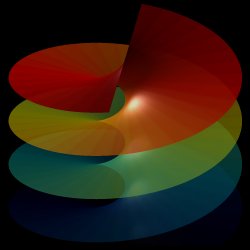
Twisting phase. The phase of an electron or optical vortex twists spirally around the direction of propagation of the beam. Because of this spiral movement, the light waves cancel each other out at the center of the beam, so that the optical vortex looks like a doughnut, a ring of light with a dark hole at its center.
Twisted Elektronit
translated by Oskari Laine.
What can be qualified as twisted? A wire? Or a rope, perhaps? You can twist your ankle, painful as that may sound. Logic and sense of humor can also be twisted. The adjective twisted, in its literal or metaphorical sense, can be applied to qualify a range of concepts and objects in everyday life or, indeed, in a research lab. What about quantum particles like electrons? Can they be twisted? They literally can. This has been shown in a recent experiment where a beam of twisted electrons was generated by a hologram. The experiment was performed by Johan Verbeeck and He Tian at the University of Antwerp (Belgium), and Peter Schattschneider at the Vienna University of Technology (Austria).
Electrons are elementary particles, a little like photons; but what exactly does twisted mean when used to refer to electrons or, prior to that, to photons [1]? The photons of a laser beam, for example, normally travel along the direction of propagation with a constant phase, like a squad of soldiers all marching at the same pace. An optical vortex is a beam of light whose phase twists spirally along the direction of propagation of the beam [2]. Because of this spiral movement, the optical vortex looks like a doughnut: a ring of light with a dark hole in its center.
Electrons, like photons, can also be induced to twist along the direction of propagation. "The first demonstration of an electron vortex beam was given by Uchida and colleagues [3] by making use of an accidental stacking of thin graphite flakes that acted as a rough approximation to a spiral phase plate," explains Verbeeck. "Our work shows that, by making use of a technique called holographic reconstruction, already in use with photons, a much more reproducible setup can be obtained. This method is based on a computer-designed hologram that encodes a complex wave function of choice. In this case, we chose a wave function with a helical wave-front structure."
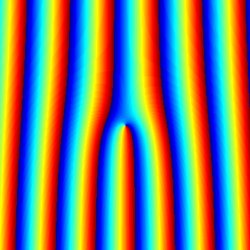
The pitch-fork hologram. The pitch-fork hologram, which has been traditionally used to generate optical vortices, can now also be used to generate electron vortices. The singular point at the centre is the main reason for the production of the vortex, and it also gives the hologram its name.
Electron vortices are likely to help expand the range of applications of electron microscopy. Since its invention in 1931, this field has made giant leaps forward and it is nowadays widely used in research and industrial labs for many applications, such as imaging, spectroscopy or lithography, where a high resolution of a few nanometers is essential. "The field in which electron vortices will be most useful is that of electron spectroscopy," says Verbeeck. "We have demonstrated that, when using electron vortex beams instead of conventional plane waves, we get a different spectrum in electron energy spectroscopy for ferromagnetic materials. These electron vortices, therefore, can be a very useful tool in determining magnetism in materials on the atomic scale."
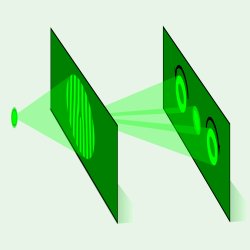
Electron holography. The pitch-fork hologram transforms a conventional electron beam into a doughnut shaped beam.
[1] G. Molina-Terriza, J. P. Torres & L. Torner, Twisted Photons, Nat. Phys. 3, 305-310 (2007).
[2] S. Cherukulappurath, Tiny Plasmonic Whirpools, Opt. Photon. Focus 8, 7 (2010) (link).
[3] M. Uchida & A. Tonomura, Generation of Electron Beams Carrying Orbital Angular Momentum, Nature 464 737-739 (2010).
Giorgio Volpe
2011 © Optics & Photonics Focus
GV is currently working on his doctoral thesis at ICFO - The Institute of Photonic Sciences, Barcelona (Spain).

J. Verbeeck, H. Tian & P. Schattschneider, Production and application of electron vortex beams, Nature (2010) 467, 301-304 (link).